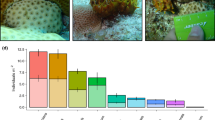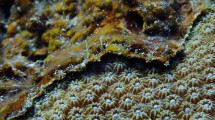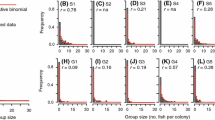Abstract
In Belize, shallow fore-reef buttresses are dominated byAgaricia tenuifolia Dana. The ecological importance of this fragile coral in such a high-energy environment may be explained in part by an unusual cooperative interaction between adjacent clones ofA. tenuifolia. The shallow buttresses are often composed primarily of many clones ofA. tenuifolia growing in close proximity. Surveys conducted at Carrie Bow Cay, Belize, in 1986 and 1987 showed that intraspecific contacts between different clones are common and occur far more frequently than interspecific encounters with other sessile taxa. In contrast to many other corals, contacts between non-clonemates ofA. tenuifolia do not result in competitive interactions, tissue bleaching or death, or significantly altered patterns of colony growth. Instead, inter-clonal contact stimulates localized morphological changes in the skeletons of both corals directly beneath the contact interface, which tend to anchor the two corals against each other, making them more resistant to breakage and detachment. By mechanically stabilizing clusters of otherwise fragile corals, these cooperative interactions potentially enhance the long-term survivorship and hence the fitness of interactingA. tenuifolia clones.
Similar content being viewed by others
Literature cited
Bak, R. P. M., Criens, S. R. (1982). Experimental fusion in AtlanticAcropora (Scleractinia). Mar. Biol. Lett. 3: 67–72
Cairns, S. D. (1982). Stony corals (Cnidaria: Hydrozoa, Scleractinia) of Carrie Bow Cay, Belize. Smithson. Contr. mar. Sci. 12: 271–302
Chamberlain, J. A., Graus, R. R. (1975). Water flow and hydromechanical adaptations of branched reef corals. Bull. mar. Sci. 25: 112–125
Chornesky, E. A. (1983). Induced development of sweeper tentacles on the reef coralAgaricia agaricites: a response to direct competition. Biol. Bull. mar. biol. Lab., Woods Hole 165: 569–581
Chornesky, E. A. (1984). The consequences of direct competition between scleractinian reef corals: development and use of sweeper tentacles. Ph.D. thesis, University of Texas at Austin, Texas
Chornesky, E. A. (1989). Repeated reversals during spatial competition between corals. Ecology 70: 843–855
Collins, J. D. (1978). A study of the interactive biology of corals. Masters thesis, The James Cook Univ. of North Queensland
Gilmore, M. D., Hall, B. R. (1976). Life history, growth habits, and constructional roles ofAcropora cervicornis in the patch reef environment. J. Sed. Pet. 46: 519–522
Goreau, T. F. (1959). The ecology of Jamaican coral reefs 1. Species composition and zonation. Ecology 40: 67–90
Heyward, A. J., Stoddart, J. A. (1985). Genetic structure of two species ofMontipora on a patch reef: conflicting results from electrophoresis and histocompatibility. Mar. Biol. 85: 117–121
Hidaka, M. (1985a). Nematocyst discharge, histoincompatibility, and the formation of sweeper tentacles in the coralGalaxea fascicularis. Biol. Bull. 168: 350–358
Hidaka, M. (1985b). Tissue compatibility between colonies and between newly settled larvae ofPocillopora damicornis. Coral Reefs 4: 111–116
Hidaka, M., Yamazato, K. (1984). Intraspecific interactions in a scleractinian coral,Galaxea fascicularis: induced formation of sweeper tentacles. Coral Reefs 3: 77–85
Hildemann, W. H., Jokiel, P. L., Bigger, C. H., Johnston, I. S. (1980). Allogenic polymorphism and alloimmune memory in the coral,Montipora verrucosa. Transplantation 30: 297–301
Hildemann, W. H., Linthicum, D. S., Vann, D. C. (1975). Transplantation and immunoincompatibility reactions among reefbuilding corals. Immunogenetics 2: 269–284
Hildemann, W. H., Raison, R. L., Hull, C. J., Akaka, L., Okumoto, J., Cheung, G. (1977). Tissue transplantation immunity in corals. Proc. 3rd int. coral Reef Symp. 537–543 [Taylor, D. L. (ed.) Rosenstiel School of Marine and Atmospheric Science, University of Miami, Miami]
Hunter, C. L. (1985). Assessment of clonal diversity and population structure ofPorites compressa (Cnidaria, Scleractinia). Proc. 5th int. coral Reef Congr. 6: 69–74 [Gabrié, C. et al. (eds.) Antenne Museum — EPHE, Moorea, French Polynesia]
Hunter, C. L., Kehoe, C. C. (1986). Patchwork patchreefs: the clonal diversity of the coralPorites compressa in Kaneohe Bay, Hawaii. In: Jokiel, P. L., Richmond, R. H., Rogers, R. A. (eds.) Coral reef population biology. Hawaii Inst. of Mar. Biol. Tech. Rep. 37, Sea Grant Coop. Rep. UNIHI-SEAGRANT-CR-86-01, p. 124–132
Jokiel, P. L. (1978). Effects of water motion on reef corals. J. exp. mar. Biol. Ecol. 35: 87–97
Jokiel, P. L., Hildemann, W. H., Bigger, C. H. (1983). Clonal population structure of two sympatric species of the reef coralMontipora. Bull. mar. Sci. 33: 181–187
Lang, J. C. (1971). Interspecific aggression by scleractinian corals. 1. The rediscovery ofScolymia cubensis (Milne Edwards & Haime). Bull. mar. Sci. 21: 952–959
Lang, J. C. (1973). Interspecific aggression by scleractinian corals. 2. Why the race is not only to the swift. Bull. mar. Sci. 23: 260–279
Lang, J. C., Chornesky, E. A. (1990). Competition between scleractinian reef corals: a review of mechanisms and effects. In: Dubinsky, Z. (ed.) Ecosystems of the world: coral reefs. Elsevier Press, Amsterdam
Logan, A. (1985). Intraspecific immunological responses in five species of corals from Bermuda. Proc. 5th int. coral Reef Congr. 6: 63–67 [Gabrié, C. et al. (eds.) Antenne Museum — EPHE, Moorea, French Polynesia]
Neigel, J. E., Avise, J. C. (1983). Clonal diversity and population structure in a reef-building coral,Acropora cervicornis: selfrecognition analysis and demographic interpretation. Evolution, Lawrence, Kansas 37: 437–453
Potts, D. C. (1976). Growth interactions among morphological variants of the coralAcropora palifera. In: Mackie, G. O. (ed.) Coelenterate ecology and behavior. Plenum Press, New York, p. 79–88
Resing, J. M., Ayre, D. J. (1985). The usefulness of the tissue grafting bioassay as an indicator of clonal identity in scleractinian corals (Great Barrier Reef Australia). Proc. 5th int. coral Reef, Congr. 6: 75–81 [Gabrié, C. et al. (eds.) Antenne Museum — EPHE, Moorea, French Polynesia]
Rinkevich, B., Loya Y (1983a). Intraspecific competitive networks in the Red Sea coralStylophora pistillata. Coral Reefs 1: 161–172
Rinkevich, B., Loya, Y (1983b). Oriented translocation of energy in grafted reef corals. Coral Reefs 1: 243–247
Rinkevich, B., Loya, Y. (1985). Intraspecific competition in a reef coral: effects on growth and reproduction. Oecologia 66: 100–105
Rinkevich, B., Weissman, I. L. (1987). Chimeras in colonial invertebrates: a synergistic symbiosis or somatic- and germ-cell parasitism. Symbioses 4: 117–134
Rützler K., Macintyre, I. G. (1982). The habitat distribution and community structure of the barrier reef complex at Carrie Bow Cay, Belize. Smithson. Contr. mar. Sci. 12: 9–45
Sokal, R. R., Rohlf, F. J. (1969). Biometry. The principles and practice of statistics in biological research. W. H. Freeman & Co., San Francisco
Stoddart, J. A., Ayre, D. J., Willis, B., Heyward, A. J. (1985). Selfrecognition in sponges and corals? Evolution, Lawrence, Kansas 39: 461–463
Tunnicliffe, V. (1978). The role of boring sponges in coral fracture. In: Levi, C., Boury-Esnault, N. (eds.) Biologie des spongaires. Centre National de la Recherche Scientifique, Paris, p. 309–315
Wainwright, S. A., Biggs, W. D., Currey, J. D., Gosline, J. M. (1976). Mechanical design in organisms. John Wiley & Sons, New York
Wells, J. W. (1973). New and old scleractinian corals from Jamaica. Bull. mar. Sci. 23: 16–53
Willis, B. L., Ayre, D. J. (1985). Asexual reproduction and genetic determination of growth form in the coralPavona cactus: biochemical genetic and immunogenic evidence. Oecologia 65: 516–525
Wulff, J. L., Buss, L. W. (1979). Do sponges help hold coral reefs together? Nature, Lond. 281: 474–475
Author information
Authors and Affiliations
Additional information
Communicated by J. Grassle, New Brunswick
The views expressed here are those of the author and do not necessarily reflect those of the Office of Technology Assessment
Rights and permissions
About this article
Cite this article
Chornesky, E.A. The ties that bind: Inter-clonal cooperation may help a fragile coral dominate shallow high-energy reefs. Mar. Biol. 109, 41–51 (1991). https://doi.org/10.1007/BF01320230
Accepted:
Issue Date:
DOI: https://doi.org/10.1007/BF01320230




